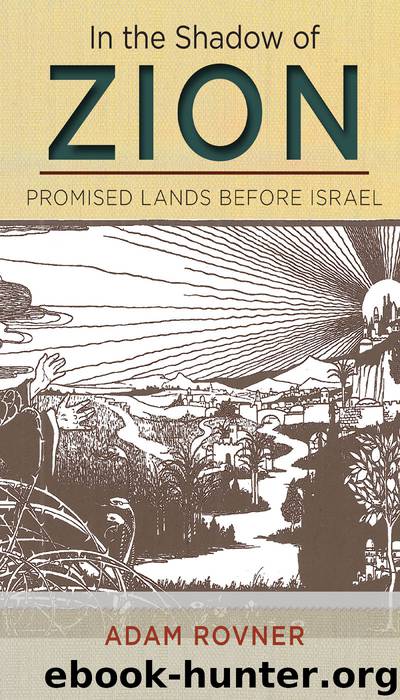In the Shadow of Zion by Adam Rovner

Author:Adam Rovner
Language: eng
Format: epub
Publisher: NYU Press
Published: 2014-07-25T16:00:00+00:00
Fatal Shore
Tasmania is the land down under the land down under. The smallest of Australia’s six states, the island is about the size of Ireland and lies 150 miles from the mainland. Tasmania’s meager population and lack of industrial development make it a relatively unspoiled Eden. But Tassie, as locals call it, also possesses a lurid past as a brutal penal colony, and it was the site of what some consider to be a genocide against its Aboriginal inhabitants. Dutch explorer Abel Tasman set out to find terra australis incognita—the unknown southern land—in 1642. At the time, many believed in the existence of a mythical temperate continent rich in gold located at the bottom of the known world. Abel Tasman couldn’t find what didn’t exist, but he did discover a forested island he named Van Diemen’s Land, after a Dutch official. Great Britain claimed Van Diemen’s Land in 1803, and focused a host of settlement schemes on the territory. Various groups and individuals put forward proposals to establish progressive collectives there throughout the nineteenth century.117 All ended in failure.
Like many utopian dreams, the reality of Van Diemen’s Land descended into nightmare. Abel’s sylvan island became a dumping ground for those bearing the mark of Cain. Until 1853, Van Diemen’s Land served as a penal colony for criminals transported from England. The first miserable vessels sailing to the island spent from three to four months at sea.118 Slave ships that had once made the Middle Passage now carried British prisoners in chains119 to Van Diemen’s Land’s “fatal shore.”120 Inmates faced a grim life of servitude, dank cells, and corporal punishment when they arrived in the police state. Those who reformed themselves through good behavior could be granted a ticket of leave enabling them to make a new life in the colony. Through the first half of the nineteenth century, a majority of the islanders were or had been transported convicts.121
One Londoner who was not a convict, George Augustus Robinson, arrived in Tasmania in 1824 and soon established himself as a “hardworking and public-spirited man.”122 Robinson, a builder, was of average height for his day,123 wore a wavy-haired wig,124 and had a doughy face and a prominent nose.125 He lacked formal education but was an avid reader of travelogues and novels.126 The most significant literary influence on his character was surely the Bible. There are few hints in the first years of his residency in Hobart that Robinson would soon vault himself into the position of the Aborigines’ savior. But after years of skirmishes between tribesmen and the white settlers, the devout Robinson applied to the colony’s equally devout lieutenant governor, George Arthur, to “ameliorate the condition of the aboriginal inhabitants.”127 He was a sensitive man, unusual in his day for recognizing that the Aborigines were human beings “made after the express image of God.”128 At one point, Robinson records that he “imagined himself an aborigine”129 and broke down and wept in the grip of his humanist vision: “God has made of one blood all nations of people and I am not ashamed to call them brothers.
Download
This site does not store any files on its server. We only index and link to content provided by other sites. Please contact the content providers to delete copyright contents if any and email us, we'll remove relevant links or contents immediately.
| Africa | Americas |
| Arctic & Antarctica | Asia |
| Australia & Oceania | Europe |
| Middle East | Russia |
| United States | World |
| Ancient Civilizations | Military |
| Historical Study & Educational Resources |
Cecilia; Or, Memoirs of an Heiress — Volume 1 by Fanny Burney(32061)
Cecilia; Or, Memoirs of an Heiress — Volume 3 by Fanny Burney(31457)
Cecilia; Or, Memoirs of an Heiress — Volume 2 by Fanny Burney(31408)
The Secret History by Donna Tartt(18161)
Sapiens: A Brief History of Humankind by Yuval Noah Harari(13988)
Leonardo da Vinci by Walter Isaacson(12803)
The Radium Girls by Kate Moore(11621)
Sapiens by Yuval Noah Harari(5122)
How Democracies Die by Steven Levitsky & Daniel Ziblatt(4958)
The Wind in My Hair by Masih Alinejad(4841)
Homo Deus: A Brief History of Tomorrow by Yuval Noah Harari(4690)
Endurance: Shackleton's Incredible Voyage by Alfred Lansing(4505)
The Silk Roads by Peter Frankopan(4272)
Man's Search for Meaning by Viktor Frankl(4271)
Millionaire: The Philanderer, Gambler, and Duelist Who Invented Modern Finance by Janet Gleeson(4096)
The Rape of Nanking by Iris Chang(4022)
Hitler in Los Angeles by Steven J. Ross(3798)
The Motorcycle Diaries by Ernesto Che Guevara(3786)
Joan of Arc by Mary Gordon(3782)
